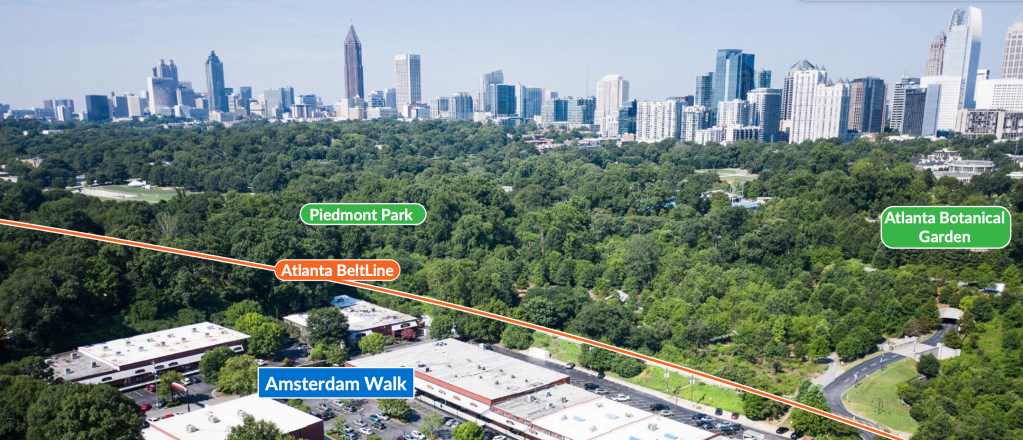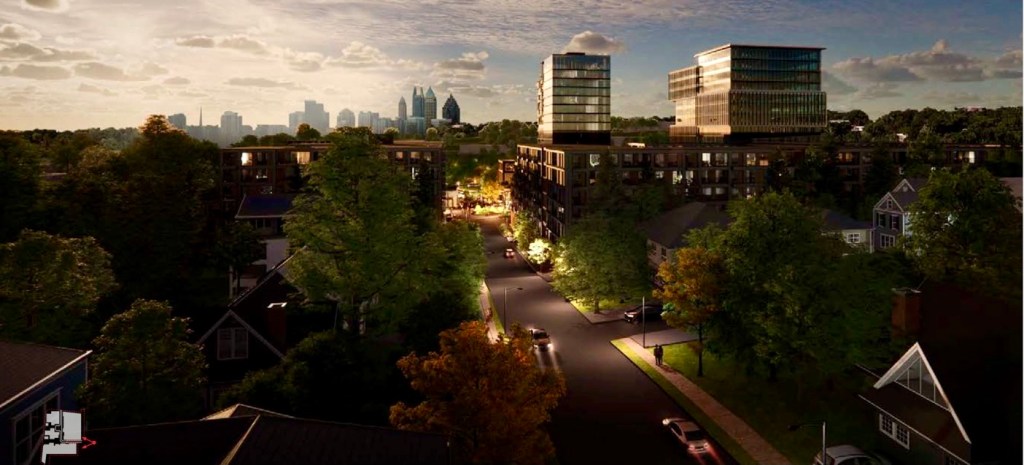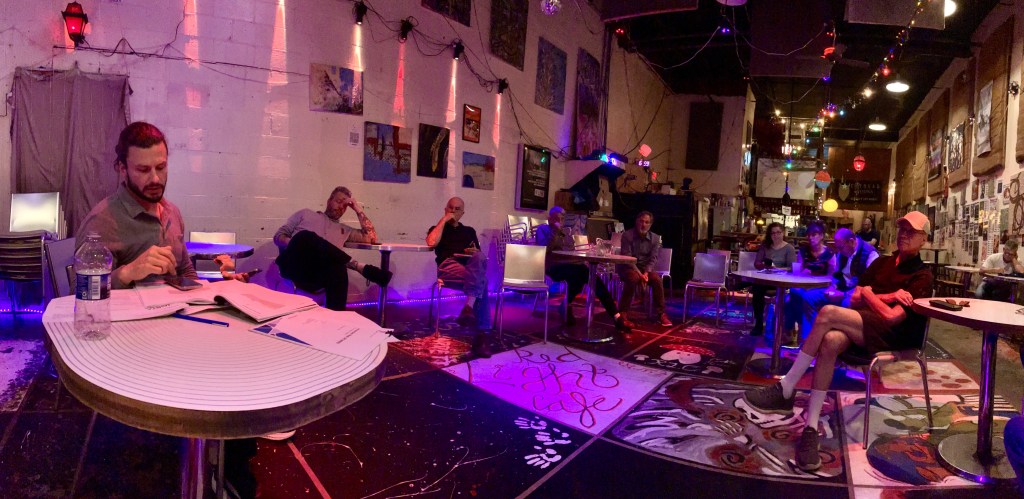Portman’s plans for Amsterdam Walk ‘incompatible’ with Va-Hi, Morningside-Lenox aesthetic, some residents say

Portman Holdings’ plans to transform Amsterdam Walk from a small-scale shopping center into a large mixed-use development adjacent to the Atlanta BeltLine is “incompatible” with the surrounding single-family neighborhoods, according to some residents.
About 20 people from the Virginia-Highland and Morningside-Lenox neighborhoods met March 27 with Mike Greene, senior vice president of development at Portman. The roundtable discussion, held at the Red Light Cafe in Amsterdam Walk, was set up by Greene to answer questions and clear up any misinformation floating on social media.
Most residents attending repeated their frustrations and fears about Portman’s plans to redevelop the approximately 10-acre site nestled between Piedmont Park and their neighborhoods with 900 apartments and about 500,000 square feet of retail and office space.
The proposal includes two high-rise buildings — a 13-story office tower and 17-story apartment building — and more than 1,000 parking spaces.
“This will turn Morningside into Atlantic Station 2 or Buckhead 2,” Charlie Kaften told Greene. “How does this fit in? It doesn’t.”
Another person said the heights of the buildings are “inappropriate” and would be an “eyesore.” The development would stand out like a “growth” amid the greenery of the park and manicured lawns of single-family homes, they said.
Then there’s traffic. The main entrance into Amsterdam Walk is Amsterdam Avenue, off Monroe Drive. Traffic on Monroe is already a burden, several people said. Adding 900 apartments and an office building and retail on the site with one main entrance and exit would force people to drive over Monroe and onto residential streets.
Portman is investing more than a billion dollars in the project and it is essential people are able to get to it for it to be successful, he said.
Greene acknowledged what Portman is planning doesn’t fit in with the area. But he said his company paid for a traffic study that said after the city finishes its Monroe road diet project, traffic would not be great but it would not be much worse than now.
“Saying you’re going to do a commercial development in a neighborhood, of predominantly [single-family] homes is not the definition of fitting in,” he said.

“But if the question is related to height and does there exist buildings of similar heights that are at least that adjacent to single family homes? The answer is definitively yes. And it’s not even uncommon in Atlanta,” Greene said.
But those areas are not like Va-Hi or Morningside, residents argued.
During the past 15 years or so, zero apartments have been built in Va-Hi, Greene said. Only about 900 apartment units have been built in Morningside in that same time, Greene said.
“And we want to keep it that way,” a person said.
“I understand. Some people do. Some people do,” Greene said.
“You might ask me, ‘How dare you have the audacity to propose this development in what is seemingly mostly a single-family residential neighborhood?’” Greene added. “Well, I think the city of Atlanta has a desperate need to continue to build housing to support its growth. And that’s been echoed by most of the city council.”

Greene reminded everyone the Amsterdam Walk property, owned by Halpern Enterprises and a partner in the planned development, is already zoned C-1 commercial despite its location within these neighborhoods.
The current zoning allows for about 750,000 square feet of non-residential use and more than 300,000 square feet of residential, for a total of more than 1 million square feet of new development. There are also no height limits in C-1.
Halpern owns one of the rare spots in the city where density can be added and at the same time preserve single-family neighborhoods, Greene said. Portman is under contract to buy the property only after the city approves the project.
“That is really the underlying basis for why we had the audacity to propose the design we did,” Greene said. “It’s because it already possessed a large density on it.”
Greene has also said Portman won’t go through with the project if the residents don’t want it.
But Halpern understands the value of the property. C-1 does not mean only office space. C-1 zoning allows for building banks and other financial institutions, commercial schools, childcare centers, specialty schools, churches, synagogues, temples, mosques, other religious worship areas, clubs and lounges, commercial greenhouses, commercial recreation establishments, including bowling alleys, theaters and convention halls.

C-1 does allow for some apartments, but Portman wants to rezone the property to mixed-use to be able to build 900 rental units.
The Virginia-Highland master plan calls for development on the site, but it calls for “compatible development in scale and scope,” Kaften said, and the Portman project is not compatible.
“We don’t want Atlantic Station here in Morningside,” said Kaften. “I think that’s the bottom line.”
But Jack White, longtime member of the Va-Hi Civic Association and current member of the planning committee, said Portman’s proposal “substantially” fits with the neighborhood’s master plan, including building predominantly residential along the Beltline.
And the project preserves single-family homes, he said.
Mark Campis, another Va-Hi Civic Association planning committee member, said there are about 10,000 people who live in the two neighborhoods, but only 20 people showed up for the March 27 meeting.
The civic groups are in talks with Portman about conditions they want if the project is approved, such as building a streetscape to improve pedestrian and bike safety in the area.
Conditions could also include asking Portman to scale the project back. But Greene stressed that Portman, and especially Halpern, have to build enough density to make a profit.
A vote by the civic groups is expected by May. After their votes, Portman would then take their plans to Neighborhood Planning Units E and F and ask for support.
The current pace could put the project before the city’s zoning review board in June. After the ZRB vote to recommend approval or not, the Amsterdam Walk project would go to the city council for a final vote.
Greene plans more roundtable discussions with concerned residents at the Red Light Cafe on April 10, April 17 and April 24. The meetings will be from 5 to 7 p.m.





